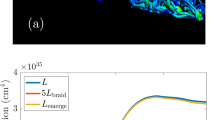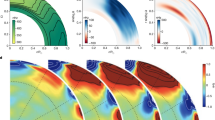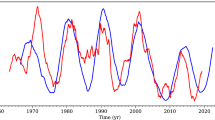Abstract
In the past two decades dynamo models of solar activity and the physical foundations of the solar cycle have become acceptable. However, recent observations revealing the concentrated form of photospheric magnetic flux1, the distribution and cyclic appearance of X-ray bright points2,3 and ephemeral active regions4, as well as the discovery of sunspot brightness variations during the solar cycle5,6, have raised some questions about the dynamo theory of solar activity7. Both observation and theory8 suggest that most of the magnetic flux in the solar convection zone is in the form of concentrated isolated magnetic flux tubes. The turbulent dynamo theory9,10 has, therefore, to be modified and attempts have been made to include concentrated fields11. Nevertheless, the dynamo problem for a convective medium pervaded by concentrated flux tubes, the ‘flux tube dynamo’, has not yet been solved. The problem is to regenerate the poloidal magnetic field out of which toroidal field is produced by differential rotation. Here the consequences and the structure of the resulting cycle are considered if a field regeneration process operating on flux tubes is assumed. A calculation similar to Leighton's magneto–kinematic model12 shows that a flux tube dynamo model can operate and reproduce the essential features of the solar cycle. It can also explain the cyclic variation of sunspot brightness and ephemeral active regions.
This is a preview of subscription content, access via your institution
Access options
Subscribe to this journal
Receive 51 print issues and online access
$199.00 per year
only $3.90 per issue
Buy this article
- Purchase on SpringerLink
- Instant access to full article PDF
Prices may be subject to local taxes which are calculated during checkout
Similar content being viewed by others
References
Harvey, J. W. Highlights of Astronomy Vol. 4, II (ed. Müller, E. A.) 223–239 (Reidel, Dordrecht, 1977).
Davis, J. M., Golub, L. & Krieger, A. S. Astrophys. J. Lett. 214, L141–144 (1977).
Golub, L., Davis, J. M. & Krieger, A. S. Astrophys. J. Lett. 229, L145–150 (1979).
Martin, S. F. & Harvey, K. L. Sol. Phys. 64, 93–108 (1979).
Albregtsen, F. & Maltby, P. Nature 274, 41–42 (1978).
Maltby, P. & Albregtsen, F. Astrophys. J. 234, L147–149 (1979).
Jensen, E., Nordø, J. & Ringnes, T. S. Astrophys. Norv. 5, 167–205 (1955).
Galloway, D. J., Proctor, M. R. E. & Weiss, N. O. J. Fluid Mech. 87, 243–261 (1978).
Parker, E. N. Cosmical Magnetic Fields (Clarendon, Oxford, 1979).
Moffat, H. K. Magnetic Field Generation in Electrically Conducting Fluids (Cambridge University Press, 1978).
Childress, S. Pap. Conf. on Origins of Planetary Magnetism, Houston (1978).
Leighton, R. B. Astrophys, J. 156, 1–26 (1969).
Schüssler, M. Astr. Astrophys. 71, 79–91 (1979).
Dicke, R. H. Nature 276, 676–680 (1978).
Author information
Authors and Affiliations
Rights and permissions
About this article
Cite this article
Schüssler, M. Flux tube dynamo approach to the solar cycle. Nature 288, 150–152 (1980). https://doi.org/10.1038/288150a0
Received:
Accepted:
Issue date:
DOI: https://doi.org/10.1038/288150a0
This article is cited by
-
Structural Invariance of Sunspot Umbrae over the Solar Cycle: 1993 – 2004
Solar Physics (2010)
-
Intensity and Magnetic Field Distribution of Sunspots
Solar Physics (2008)
-
Sunspots with the Strongest Magnetic Fields
Solar Physics (2006)



